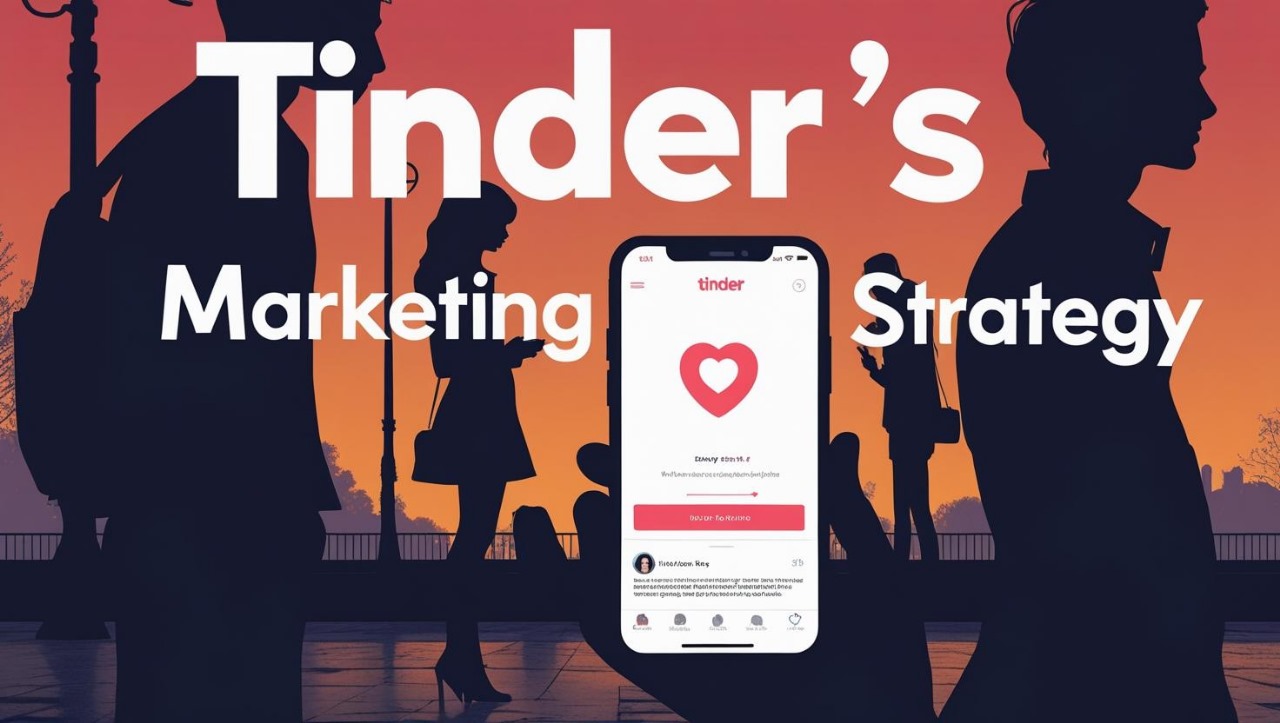Tinder Marketing Strategy: How Tinder Became a Global Dating Giant
Tinder is one of the most famous dating apps in the world. It changed the way people meet online by introducing the simple "swipe right" and "swipe left" feature. But what made Tinder so popular wasn't just the technology—it was how the company marketed itself cleverly and consistently.
In this blog, we will talk about Tinder’s journey, its target audience, the marketing strategies it uses, and how it competes in a crowded market. We’ll also see what digital marketers can learn from Tinder’s success.
Tinder’s Journey and Year-on-Year Growth:
Tinder was launched in 2012 as part of a hackathon at Hatch Labs. The idea was to create a dating app that made finding a match simple, fun, and quick. It started as a small project but quickly became popular, especially among college students.
Here is how Tinder has grown over the years:
2013: Tinder had over 1 million swipes every day.
2014: The app reached 1 billion swipes per day.
2015: Tinder expanded to more than 190 countries.
2016: Over 50 million users were active each month.
2018: Tinder became one of the top-grossing apps on Apple’s App Store.
2020: Tinder made over 1.4 billion dollars in revenue.
2023: Tinder had more than 75 million monthly active users.
2024: The revenue crossed 1.8 billion dollars, with over 100 billion matches made globally.
This fast growth was not only because of the app’s features but also because of strong and smart marketing.
Tinder’s Target Audience
Tinder mainly targets:
Age group: 18 to 35 years old
Location: Urban areas and college towns
Profession: Students, young professionals, tech-savvy users
Interests: Social networking, dating, casual relationships, and exploring new people
Tinder’s fun and casual tone appeals mostly to Gen Z and Millennials, who spend a lot of time on mobile and social apps.
Tinder’s Marketing Strategies
Tinder uses a mix of online and offline marketing to reach its audience. Here are the main strategies they use:
Guerrilla Marketing
What is it: Guerrilla marketing means using creative, low-cost, and surprise tactics to promote a brand in public spaces.
What Tinder did:
Tinder once placed a giant matchbox installation in a busy public space. At first, people were curious but didn’t understand what it meant. Later, as they noticed Tinder’s logo on it, they understood the smart play on words — "It’s a Match," which is Tinder’s signature phrase. This creative and eye-catching stunt was a perfect example of a successful guerrilla marketing campaign.
Buzz Marketing:
What is it: Buzz marketing means creating excitement and word-of-mouth through viral content and conversation.
What Tinder did:
Back in 2015, the NBA team Atlanta Hawks hosted a special event called "Swipe Right Night." During this event, a couple who originally met on Tinder reconnected and started dating again. At the same event the following year, the Hawks’ CEO made a unique promise—he offered to pay for their wedding if they chose to get married. In 2018, the couple tied the knot, and true to his word, the CEO covered the wedding expenses. Tinder also joined in and paid for the couple’s honeymoon. This heartwarming story attracted a lot of positive attention, helping Tinder grow its user base and encouraging more people to give swiping right a try.
Meme Marketing
Tinder has effectively used meme marketing to connect with its younger audience, especially Gen Z and Millennials. Meme marketing involves creating and sharing funny, relatable images, videos, or jokes that people enjoy and often share with others. These memes usually reflect everyday situations, online trends, or social behavior.
Tinder regularly posts humorous and light-hearted memes related to dating, relationships, awkward texting, and online matchmaking. These memes are shared on platforms like Instagram, Twitter, and Facebook, where their audience is most active.
SEO Strategy of Tinder :
What is it: SEO, or Search Engine Optimization, is the process of improving a website so that it appears higher in search engine results like Google. This helps attract more visitors organically (without paying for ads).
Tinder has done a great job with SEO by focusing on high-ranking keywords, clean website design, fast loading speed, and informative content that answers user questions.
Let’s break this down further:
UI and UX Design
User Interface (UI): Tinder's website has a clean and modern design. The color scheme is simple—mostly white and red, matching the app branding. The layout is mobile-friendly and easy to navigate.
User Experience (UX): Pages load quickly, links work properly, and all important content is easy to find. This helps users stay longer on the site and improves engagement—both of which are good for SEO.
A well-designed UI and good UX reduce bounce rate and increase time-on-site, which signals to Google that the site is useful and relevant.
Popular Keywords Tinder Ranks For
Tinder ranks well on Google for several high-volume search keywords. These keywords help bring millions of users to their website every month.
Some popular keywords include:
"Best dating apps"
"Dating App in India"
"Free dating app"
These keywords are well-targeted because they reflect what users are searching for when looking for dating apps or trying to learn more about Tinder.
Organic Traffic and Bounce Rate
Based on recent web analytics reports (like SimilarWeb and SEMrush):
Monthly Organic Traffic: Tinder.com receives approximately 53.7 million visits per month through organic search.
Bounce Rate: Around 22.53%, which is considered very good. This means users are engaging with the content instead of leaving immediately.
Average Visit Duration: 2 to 3 minutes, which indicates users find the information helpful.
Social Media Marketing
Tinder actively uses platforms like Facebook, Instagram, and YouTube to reach its audience.
Facebook:
Tinder runs targeted ads based on age, gender, and location.
They test different versions of ads to see what works best.
Many of these ads lead directly to app downloads.
Instagram:
Posts funny memes, success stories, and user experiences.
Instagram Reels and Stories are used to connect with Gen Z users.
Tinder also uses branded hashtags like #SwipeRight and #SingleNotSorry.
YouTube:
Tinder makes storytelling ads and short films.
These ads often show real or fictional dating stories with emotion or humor.
The brand has also collaborated with YouTube influencers to reach wider audiences.
Influencer Marketing
What is it: Partnering with social media influencers to promote the app to their followers.
What Tinder did:
Tinder works with Instagram, YouTube, and TikTok influencers who talk about dating, lifestyle, or relationships.
Influencers share personal stories or experiences using the app.
In India, influencers like Kusha Kapila helped promote Tinder in a relatable and humorous way.
Brand Collaborations
What is it: Working with other well-known brands to reach a larger or different audience.
Tinder’s collaborations:
Partnered with Netflix to promote dating-related shows.
Collaborated with Spotify to let users show their favorite music on their Tinder profile.
In India, partnered with Zomato for funny campaigns about dating and food.
Push Notification Strategy
What is it: Sending alerts on users’ phones to keep them engaged with the app.
Tinder’s approach:
Sends real-time notifications like “You got a new match!” or “Someone swiped right on you.”
Sends reminders based on location and time, especially during weekends or evenings.
Pushes special promotions or in-app events to increase usage.
Competitors of Tinder
Even though Tinder is a leader, there are many other dating apps in the market:
Bumble – Lets women message first and also offers friendship and networking options.
Hinge – Focuses on serious relationships and has a tagline “Designed to be deleted.”
OkCupid – Matches users based on interests and quizzes.
Tinder competes by continuously updating its features and keeping its marketing fresh.
Conclusion:
Tinder’s rise to the top wasn’t just about a simple swipe feature—it was driven by bold, creative marketing strategies like campus outreach, social media, influencer collaborations, and brand tie-ups. If you want to master these powerful techniques and launch your digital marketing career, join the Masters in Digital Marketing Course at NSIM Education Pvt Ltd—learn from experts, work on real projects, and become job-ready.


